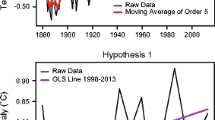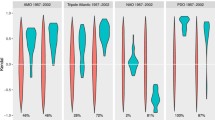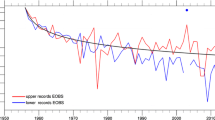Abstract
Previous estimates of the strength and the uncertainty of the observed Antarctic temperature trends assumed that the natural annual temperature fluctuations can be represented by an auto-regressive process of first order [AR(1)]. Here we find that this hypothesis is inadequate. We consider the longest observational temperature records in Antarctica and show that their variability is better represented by a long-term persistent process that has a propensity of large and enduring natural excursions from the mean. As a consequence, the statistical significance of the recent (presumably anthropogenic) Antarctic warming trend is lower than hitherto reported, while the uncertainty about its magnitude is enhanced. Indeed, all records except for one (Faraday/Vernadsky) fail to show a significant trend. When increasing the signal-to-noise ratio by considering appropriate averages of the local temperature series, we find that the warming trend is still not significant in East Antarctica and the Antarctic Peninsula. In West Antarctica, however, the significance of the trend is above \(97.4 \,\%\), and its magnitude is between 0.08 and 0.96 °C per decade. We argue that the persistent temperature fluctuations not only have a larger impact on regional warming uncertainties than previously thought but also may provide a potential mechanism for understanding the transient weakening (“hiatus”) of the regional and global temperature trends.



Similar content being viewed by others
References
Agudelo PA, Curry JA (2004) Analysis of spatial distribution in tropospheric temperature trends. Geophys Res Lett 31:L22207
Bamber JL, Riva REM, Vermeesen A, LeBrocq AM (2009) Reassessment of the potential sea-level rise from a collapse of the West Antarctic ice sheet. Science 324:901–903
Blender R, Fraedrich K (2003) Long time memory in global warming simulations. Geophys Res Lett 30:1769
Bloomfield P, Nychka D (1992) Climate spectra and detecting climate change. Clim Change 21:275–287
Bromwich DH et al (2012) Central West Antarctica among the most rapidly warming regions on Earth. Nat Geosci 6:139–145
Bromwich DH, Nicolas JP (2014) How significant is West Antarctic warming? Reply Nat Geosci 7:247
Bunde A, Büntgen U, Ludescher J, Luterbacher J, Storch H (2013) Is there memory in precipitation? Nat Clim Change 3:174–175
Bunde A, Ludescher J, Franzke C, Büntgen U (2014) How significant is West Antarctic warming? Nat Geosci 7:246–247
Cazenave A, Llovel W (2010) Contemporary sea level rise. Annu Rev Mar Sci 2:145–173
Cowtan K, Way RG (2014) Coverage bias in the HadCRUT4 temperature series and its impact on recent temperature trends. Q J R Meteorol Soc. doi:10.1002/qj.2297
Depoorter M et al (2013) Calving fluxes and basal melt rates of Antarctic ice shelves. Nature 502(7469):89–92
Eichner J, Koscielny-Bunde E, Bunde A, Havlin S, Schellnhuber HJ (2003) Power-law persistence and trends in the atmosphere: a detailed study of long temperature records. Phys Rev E 68:046133
Farman J, Gardiner B, Shanklin J (1985) Large losses of total ozone in Antarctica reveal seasonal ClOx/NOx interaction. Nature 315(6016):207–210
Fatichi S, Barbosa SM, Caporali E, Silva ME (2009) Deterministic versus stochastic trends: detection and challenges. J Geophys Res 114:D18121
Franzke C (2010) Long-range dependence and climate noise characteristics of Antarctic temperature data. J Clim 23:6074–6081
Franzke C (2012) Nonlinear trends, long-range dependence, and climate noise properties of surface temperature. J Clim 25:4172–4183
Franzke C (2013) A novel method to test for significant trends in extreme values in serially dependent time series. Geophys Res Lett 40:1391–1395
Gil-Alana LA (2005) Statistical modeling of the temperatures in the Northern Hemisphere using fractional integration techniques. J Clim 18:5357–5369
IPCC, Stocker TF et al (eds) (2013) Climate change 2013: the physical science basis. Contribution of working group I to the fifth assessment report of the Intergovernmental Panel on Climate Change, Cambridge University Press, Cambridge and New York
Joughin I, Smith BE, Medley B (2014) Marine Ice Sheet Collapse Potentially Underway for the Thwaites Glacier Basin, West Antarctica. Science 344:735–738
Khaled HH, Rao R (1998) A modified Mann–Kendall trend test for autocorrelated data. J Hydrol 204:182–196
Kalnay E, Cai M (2003) Impact of urbanization and land-use change on climate. Nature 423:528–531
Kantelhardt JW, Koscielny-Bunde E, Rego HHA, Havlin S, Bunde A (2001) Detecting long-range correlations with detrended fluctuation analysis. Phys A 295:441–454
Koscielny-Bunde et al (1998) Indication of a universal persistence law governing atmospheric variability. Phys Rev Lett 81:729–732
Kriegler E, Hall JW, Held H, Dawson R, Schellnhuber HJ (2009) Imprecise probability assessment of tipping points in the climate system. PNAS 106(13):5041–6
Kushnir Y, Robinson WA, Chang P, Robertson AW (2006) The physical basis for predicting Atlantic sector seasonal-to-interannual climate variability. J Clim 19:5949–5970
Lee S, Feldstein SB (2013) Detecting ozone- and greenhouse gas-driven wind trends with observational data. Science 339:563
Lennartz S, Bunde A (2009) Trend evaluation in records with long-term memory: application to global warming. Geophys Res Lett 36:L16706
Lennartz S, Bunde A (2009) Eliminating finite-size effects and detecting the amount of white noise in short records with long-term memory. Phys Rev E 79:066101
Lennartz S, Bunde A (2011) Distribution of natural trends in long-term correlated records: a scaling approach. Phys Rev E 84:021129
Lenton T et al (2008) Tipping elements in the Earth’s climate system. Proc Nat Acad Sci USA 105:1786–1793
Lovejoy S, Schertzer D (2012) Low frequency weather and emergence of climate. In: Sharma AS, Bunde A, Baker D, Dimri VP (eds) Extreme events and natural hazards: the complexity perspective. AGU Monographs, Washington, pp 231–254
Malamud BD, Turcotte DL (1999) Self-affine time series I: generation and analyses. Adv Geophys 40:1–90
McMillan M, Shepherd A (2014) Increased ice losses from Antarctica detected by CryoSat-2. Geophys Res Lett 41:3899–3905
Mengel M, Levermann A (2014) Ice plug prevents irreversible discharge from East Antarctica. Nat Clim Change 4:451–455
Mouginot J, Rignot E, Scheuchl B (2014) Sustained increase in ice discharge from the Amundsen Sea Embayment, West Antarctica, from 1973 to 2013. Geophys Res Lett 41:1576–1584
Pelletier JD, Turcotte DL (1997) Long-range persistence in climatological and hydrological time series: analysis, modeling and application to drought hazard assessment. J Hydrol 203:198–208
Peng CK et al (1994) Mosaic organization of DNA nucleotides. Phys Rev E 49:1685
Percival DB, Overland JE, Mofjeld HO (2001) Interpretation of North Pacific variability as short- and long-memory process. J Clim 14:4545–4559
Pritchard HD et al (2012) Antarctic ice sheet loss driven by basal melting of ice shelves. Nature 484:502505
Rignot E, Jacobs S, Mouginot J, Scheuchl B (2013) Ice-shelf melting around Antarctica. Science 341(6143):266–70
Rybski D, Bunde A, Storch H (2008) Long-term memory in 1000-year simulated temerature records. J Geophys Res Atmos 113:D02106
Santer BD et al (2000) Statistical significance of trends and trend differences in layer-average atmospheric temperature time series. J Geophys Res Atmos 105:7337
Sasgen I et al (2013) Antarctic ice-mass balance 2003 to 2012: regional reanalysis of GRACE satellite gravimetry measurements with improved estimate of glacial-isostatic adjustment based on GPS uplift rates. The Cryosphere 7(5):1499–1512
Son S-W et al (2008) The impact of stratospheric ozone recovery on the Southern Hemisphere westerly jet. Science 320:1486
Steig EJ et al (2009) Warming of the Antarctic ice-sheet surface since the 1957 International Geophysical Year. Nature 457:459–462
Stephenson DB, Pavan V, Bojariu R (2000) Is the North Atlantic Oscillation a random walk? Int J Climatol 20:1–18
Tamazian A, Ludescher J, Bunde A (2015) The significance of trends in long-term correlated records. Phys Rev E 91:032806
Thomas ER, Dennis P, Bracegirdle T, Franzke C (2009) Ice core evidence for significant 100-year regional warming on the Antarctic Peninsula. Geophys Res Lett 36:L20704
Turner J et al (2004) The SCAR READER project: toward a high-quality database of mean Antarctic meteorological observations. J Clim 17:2890–2898
Turner J et al (2005) Antarctic climate change during the last 50 years. Int J Climatol 25:279–294
Turner J, Maksym T, Phillips T, Marshell GJ, Meredith MP (2012) The impact of changes in sea ice advance on the large winter warming on the western Antarctic Peninsula. Int J Climatol 33:852–861
Vyushin D, Zhidkov I, Brenner S, Havlin S, Bunde A (2004) Volcanic forcing improves atmosphere–ocean coupled general circulation model scaling performance. Geophys Res Lett 31:L10206
Acknowledgments
We thank the British Antarctic Survey for providing us with the Reference Antarctic Data for Environmental Research (READER) dataset (www.antarctica.ac.uk/met/READER). We thank S. Colwell and Prof. J. Turner for help with the data and discussions. A.B. and C.F. thank the Deutsche Forschungsgemeinschaft for financial support. C.F. acknowledges funding from the cluster of excellence Climate System Analysis and Prediction (CliSAP). After submitting the manuscript we learnt that our DFA2 results for most of the Antarctic stations are consistent with a recently submitted study by Yuan et al. We are grateful to Naiming Yuan for sending us his article prior to publication.
Author information
Authors and Affiliations
Corresponding author
Electronic supplementary material
Below is the link to the electronic supplementary material.
Rights and permissions
About this article
Cite this article
Ludescher, J., Bunde, A., Franzke, C.L. et al. Long-term persistence enhances uncertainty about anthropogenic warming of Antarctica. Clim Dyn 46, 263–271 (2016). https://doi.org/10.1007/s00382-015-2582-5
Received:
Accepted:
Published:
Issue Date:
DOI: https://doi.org/10.1007/s00382-015-2582-5




